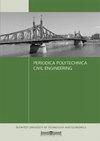Incorporation of High Loss-on-ignition Fly Ash in Producing High-strength Flowable Mortar
IF 1.4
4区 工程技术
Q3 ENGINEERING, CIVIL
引用次数: 0
Abstract
A large amount of fly ash with a high loss on ignition (over the maximum allowance value stipulated by ASTM C618) is being released and increasing daily in Vietnam. The recycling of this fly ash is still limited, while a big remaining part is disposed of in storage yards, causing environmental pollution. On the other hand, the demand for high-strength mortar as a repair material is increasing for high-rise buildings and important projects, gradually depleting natural resources. However, the application of this fly ash in the production of mortar is restricted in the literature. In this study, local fly ash with a high loss on ignition is used to replace 0%, 15%, 30%, 45%, and 60% cement content in producing high-flowability and high-strength mortar. Changes in the fresh and hardened mortar properties were systematically investigated using samples produced with various fly ash contents. Test results indicate that the effect of impurities in fly ash on the mortar’s workability can be neglected due to the spherical shape of fly ash. The unit weight, thermal conductivity, and drying shrinkage of mortars decreased with increasing fly ash content. Although some other properties of mortar are reduced due to the use of high loss-on-ignition fly ash, all mortars produced in this study still showed good quality with the presence of silica fume. In addition, the relationships between compressive strength and flexural strength with ultrasonic pulse velocity were established to predict the strength of mortar in a non-destructive method.高燃损粉煤灰在高强流动砂浆生产中的应用
在越南,大量的高着火损失(超过ASTM C618规定的最大允许值)的粉煤灰正在释放,并且每天都在增加。这些粉煤灰的回收利用仍然有限,而剩余的很大一部分被弃置在堆场,造成环境污染。另一方面,高层建筑和重要工程对高强度砂浆作为修补材料的需求不断增加,逐渐消耗自然资源。然而,在文献中,这种粉煤灰在砂浆生产中的应用受到限制。本研究采用高着火损失的本地粉煤灰替代0%、15%、30%、45%、60%水泥掺量生产高流动性高强砂浆。使用不同粉煤灰含量的样品,系统地研究了新鲜砂浆和硬化砂浆性能的变化。试验结果表明,由于粉煤灰呈球形,可以忽略粉煤灰中杂质对砂浆和易性的影响。随着粉煤灰掺量的增加,砂浆的单位重量、导热系数和干缩率均有所降低。尽管使用高燃失量粉煤灰会降低砂浆的一些其他性能,但在硅灰存在的情况下,本研究生产的所有砂浆仍然表现出良好的质量。此外,建立了超声脉冲速度与砂浆抗压强度和抗折强度的关系,以实现对砂浆强度的无损预测。
本文章由计算机程序翻译,如有差异,请以英文原文为准。
求助全文
约1分钟内获得全文
求助全文
来源期刊

Periodica Polytechnica-Civil Engineering
工程技术-工程:土木
CiteScore
3.40
自引率
16.70%
发文量
89
审稿时长
12 months
期刊介绍:
Periodica Polytechnica Civil Engineering is a peer reviewed scientific journal published by the Faculty of Civil Engineering of the Budapest University of Technology and Economics. It was founded in 1957. Publication frequency: quarterly.
Periodica Polytechnica Civil Engineering publishes both research and application oriented papers, in the area of civil engineering.
The main scope of the journal is to publish original research articles in the wide field of civil engineering, including geodesy and surveying, construction materials and engineering geology, photogrammetry and geoinformatics, geotechnics, structural engineering, architectural engineering, structural mechanics, highway and railway engineering, hydraulic and water resources engineering, sanitary and environmental engineering, engineering optimisation and history of civil engineering. The journal is abstracted by several international databases, see the main page.
 求助内容:
求助内容: 应助结果提醒方式:
应助结果提醒方式:


